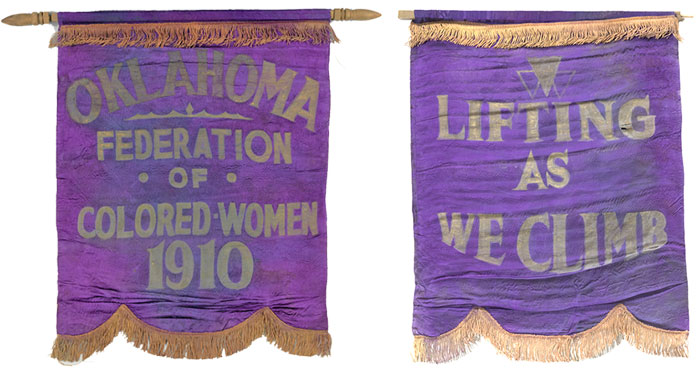
African Americans in Oklahoma Before 1954
Black Fraternities and Sororities
When Oklahoma opened for unrestricted settlement in the late nineteenth century, Blacks from the southern states brought fraternal groups with them. The Prince Hall Masons, Order of the Eastern Star, the State Federation of Colored Women’s Clubs, Knights of Pythias, Elks, Odd Fellows, and Shriners would all play an important role in the fabric of Black communities in Oklahoma. The lodges offered recreation, companionship, recognition, and talent development, which made life in a segregated world more bearable.
The organizations focused on community needs and worked to meet them. They raised funds from members and community events to devote to building and supporting the community and its members. Blacks in Oklahoma understood that the taxes they paid would not be reinvested into their own towns and neighborhoods. Black fraternal and sororal organizations filled that void throughout the state.

Order of Easter Star, Boley, 1926 (20699.02.197.303, Currie Ballard Collection, OHS).
Prince Hall Masons
Prince Hall Freemasonry began in 1775 when Prince Hall, a free Black man, organized a chapter with 14 other Black men. After the Civil War, chapters of Prince Hall Masons could be found in most Black communities in the country. Oklahoma was no exception. Most of the Black leaders in the early twentieth century belonged to one of these groups. Green I. Currin, the first Black territorial legislator, served as grand master of the St. John Grand Lodge of the AF&AM Masonic Order of Oklahoma. Civil rights leader and newspaper publisher Roscoe Dunjee’s The Black Dispatch and The Bookertee Searchlight were both considered the official publications of the state organization of the Knights of Pythias.In 1912, the Masons built a Masonic temple in Boley, which was the tallest building between Oklahoma City and Okmulgee.

Men attending a mason event, date unknown (20699.02.197.130, Currie Ballard Collection, OHS).
Queen Bathsheba Order of the Eastern Star
The Order of the Eastern Star was organized as the Indiahoma Grand Chapter in 1898. Oklahoma Territory followed with its own Queen Esther Grand Chapter in 1900. The Queen Bathsheba Grand Chapter formed in 1908 from the Grand Chapters of the Oklahoma and Indian Territories. Their work centered on collecting and paying out burial insurance for its members, scholarships for students, and contributing to charitable causes.

Bathsheba members donated $500 to survivors of the Tulsa Race Massacre (The Black Dispatch, August 26, 1921).

Letter from Queen Bathsheba Grand Chapter in Hennessey, 1916 (Currie Ballard Collection, OHS).
State Federation of Colored Women’s Clubs
The first Black women’s club predated statehood by one year; the Excelsior Club was established in Guthrie in 1906. Clubs in Oklahoma City followed a year later. By 1910, enough clubs existed in Oklahoma to organize a state-wide federation of clubs. Originally, it was called the Oklahoma Federation of Negro Women’s Clubs. In 1921, the name changed to the Oklahoma Federation of Colored Women’s Clubs. These clubs embraced charitable and political goals. Under Drusilla Dunjee Houston’s leadership, the federation protested lynching and supported women’s suffrage. They produced a publication for their membership and operated a home for young girls in Tulsa.

Oklahoma Federation of Colored Women’s Clubs banners, 1910 (image courtesy Smithsonian Institution).
Knights of Pythias

Christopher Columbus Company #1, Knights of Pythias, Oklahoma City (20699.02.197.PR.2, Currie Ballard Collection, OHS).
The Knight of Pythias was organized in Washington, DC, in 1864. The guiding principle of the organization revolved around a Greek legend about two friends who sacrificed for each other. Men in Vicksburg, Mississippi, organized the first Pythian lodge for African Americans. Much like the Masons, the Knights of Pythias offered African American members an opportunity for networking, mutual aid, and a sense of belonging. Roscoe Dunjee was a Knight of Pythias and popularized the organization within Oklahoma. He published both The Black Dispatch and, briefly, The Bookertee Searchlight, as the “official organ of the Knights of Pythias Oklahoma.”

Membership ad for the Knights of Pythias, 1919, The Bookertee Searchlight (OHS).

Still from a video by Reverend S. S. Jones, c. 1924–28. Jones was a filmmaker who chronicled everyday life in several All-Black towns (image courtesy Smithsonian National Museum of African American History and Culture).

